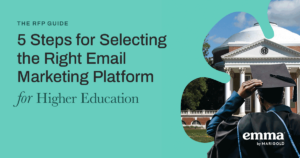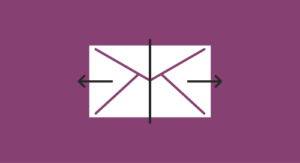Higher-ed RFP Essentials: Choosing Your Email Service Provider
Plus VIDEO: UCSB Success Story: Your chance to see one university’s program in action
Do you have an RFP in the making or are you about to post one for your higher-ed institution? Is this your first time issuing an RFP? Perhaps you're wondering what to include, what not to include, and who to involve in the crafting of it. We at Marigold – and our partners at Email Connect LLC – are here to help. Try not to look at writing and issuing an RFP for your marketing Customer Data Platform (CDP)/Email Service Provider (ESP) as a daunting task – it is more manageable than you think. Our RFP Guide for Higher Education can guide you by laying it out in easily-followed, manageable steps.While some universities or colleges may be set with their one-size-fits-all marketing technology (whether that be a CDP or ESP), finding a vendor that truly understands the higher-ed sector and your organization’s specific size and requirements for your tech stack can be a challenge. When you plan to submit a request for proposal (RFP) to email marketing vendors, you’ll need to shape your requirements lists and have a well-thought-out evaluation process. We examine ways to get all your stakeholders together; how to educate yourself on best practices; and ultimately, to select an email marketing vendor that understands both your institution and its programs well.
Higher education institutions have different guidelines and determining factors to take under consideration when implementing an email marketing program than other organizations. You can read more and gain initial insight on our Universities page. But, as for your RFP and giving it the best chance to attract the vendor that will supply your team with their best solution for success, let’s get to know the process, first.5 Steps to your perfect email marketing solution
Step 1: Get the Big Picture
Mapping out your organization’s goals and objectives will provide you with a great foundation to begin building your requirements list. You’ll do this by first asking your core team specific, integral questions and considerations like:- Your current strategy vs. future plans (6 month, 1 year, 5 year)
- New system replacement scope? (replacing components and/or point solutions or an overall CDP)?
- Your decision-making team (Marketing, Procurement, Legal, IT, Sales, etc.)
- Budget (covering purchase, implementation, launch, new program management)
- Relationship Marketing strategy fit (loyalty, experiences)
- Organizational goals and email marketing alignment
- Subscriber growth tactics and current rate of growth
- ROI analytics requirements
- Athletics: ticketing system integration
- Alumni: branding, colors and other program considerations
- Functional requirements: What the system needs to do. – Some might include: messaging, zero-party data collection, segmentation and personalization, for example. Leaders for compiling this list include those in your institution’s administration, system administrators, and strategic marketing team members tasked with driving more readership and revenue from newsletters, emails, and messaging.
- Operational requirements: These describe how the system should run. Include requirements such as user profiles, scalability, security, and customer support. These are key components to consider including in this list, which your marketing and operations teams will help generate. They contribute greatly to the overall functioning of your team and program; so these are crucial to get right with a thorough analysis involved.
- Technical requirements: How the vendor and their technology adhere to compliance, security, privacy, and IT standards. For your institution, AI and data privacy laws, security, industry regulations, and compliance mandates will all be imperative to include and plan for as they interlock with your whole system. Also, make sure to address business continuity and security incidents, as well as how you will handle customer data and firewalls/security. Consumer privacy and data privacy and security are so key in everything your consumers do online today, and the collegiate level is no exception.
Step 3: Schedule Demos and/or Issue Your RFP
There are two ways of going about this.- You will either publish a formal RFP to the field, or to a handful of vendors you’ve already vetted. Those vendors will have a certain time period to complete your RFP and submit their proposal. After you’ve reviewed all submittals, it’s time to invite your shortlist to a scheduled demo as your final round of selection. *(These demos should include some pre-developed questions that you will ask of all the vendors who demo for you. You’ll want to make sure to cover all the bases; and be consistent with them all to give fair and equal feedback time from each candidate.)
- If you prefer a more one-on-one, conversational process, start requesting demos from the vendors on your vetted list. During your process of requirements gathering, you’ll have determined everything you need to know when you start the selection process: Send them your RFP document, give them a time period to reply (usually between one month to 60 days), and upon their reply, determine if they’re a proper fit to warrant requesting and scheduling a demo.
Step 4: Scoring Your Top Vendors
Once you’ve received the respondents’ RFP bids, and given them a chance to present a functional demo to see how their email marketing platform works, you can anticipate the following steps in the pitch process:- Follow up with a call for pricing and request a sample implementation scope from the vendor.
- Request a technical demo, which brings in your team’s technical (and some marketing) team members who can dig into the inner workings of the system.
- Additional demos to dive deeper into questions or functionality you want to better understand. For example, if there are certain custom features, like countdown timers built into the email system -or- templates you may want to see.
- A longer conversation could follow about implementation, system migration, on-boarding and ongoing training.
- Opportunity to speak with customer references from the higher-ed sector to learn how they’re finding success with the vendor’s platform.
Bonus: In a nutshell
Five New Tips for Mastering Your RFP from Chris Marriott, President & Founder of Email Connect LLC- Make absolutely sure you know what your specific requirements are.
- Only invite vendors to your RFP that match those requirements.
- Don’t waste your time or that of your incumbent.
- Repeat after me: “There isn’t a best vendor, but there’s a best vendor for my (organization).
- Be okay with paying a little more to get a lot more.
Step 5: Make it Official: Choosing your Vendor of Choice
After a long – but very worthwhile – process you’ll have narrowed it down to your number one candidate, and can inform your vendor of choice you’re ready to move forward with them. Thanks to all the due diligence of you and your team, you’ll have found the right email technology vendor to build long-standing relationships with customers, future students, faculty, alumni groups and your entire audience. If you’d like to learn more, and get in-depth details of each step in this process, download our entire REQUEST FOR PROPOSAL (RFP) GUIDE for Higher-Ed, here.Customer Example: Video: UC Santa Barbara
See how one university succeeds — University of California Santa Barbara
- 99.9% delivery rate
- 40% increase in web traffic
- Knowing UCSB now has “all the building blocks in place to empower (them) to be successful” – Invaluable
MOST RECENT ARTICLES
Want to engage your audience and grow your brand? Try Emma's robust easy-to-use product today.











